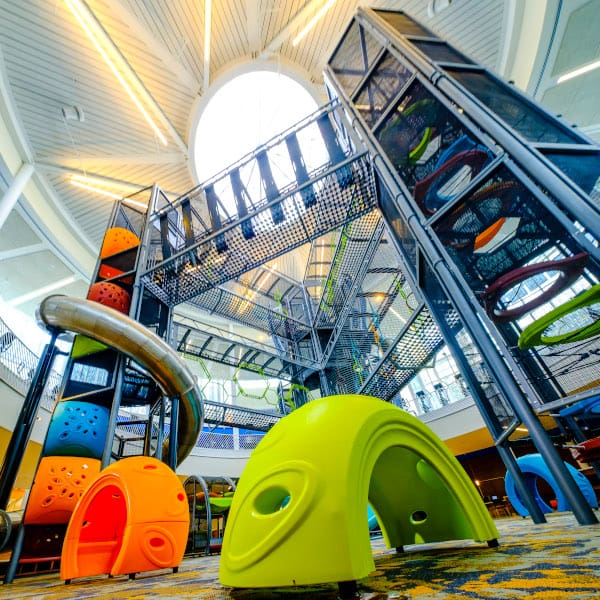The Future of Retail

The Future of Retail
Retail centers are about more than shopping — they’re a place to bring families together, meet new friends, grab a bite to eat and create memories. Families head to the mall to take pictures with Santa, to purchase homecoming and prom dresses and to find baby’s first outfit. Many malls include entertainment, restaurants, showcases and play areas that attract those in the community and fulfill visitors’ wants and needs.
But what does the future hold for retail spaces? As consumer behavior changes, will shopping centers be more at risk? Anticipate and adapt to the future of retail to ensure your retail center can thrive for years to come.
Read the full article or jump to a specific section:
- What Is The Future of Retail
- How Technology Is Changing The Future of Retail
- How The Consumer Is Changing The Future of Retail
- How Commercial Considerations Are Changing The Future of Retail
- The Future of Play Areas In Retail Design
- Benefits of Indoor Playground To The Shopping Experience
- Soft Play’s Indoor Play Spaces
- Prepare For The Future of Retail With Soft Play
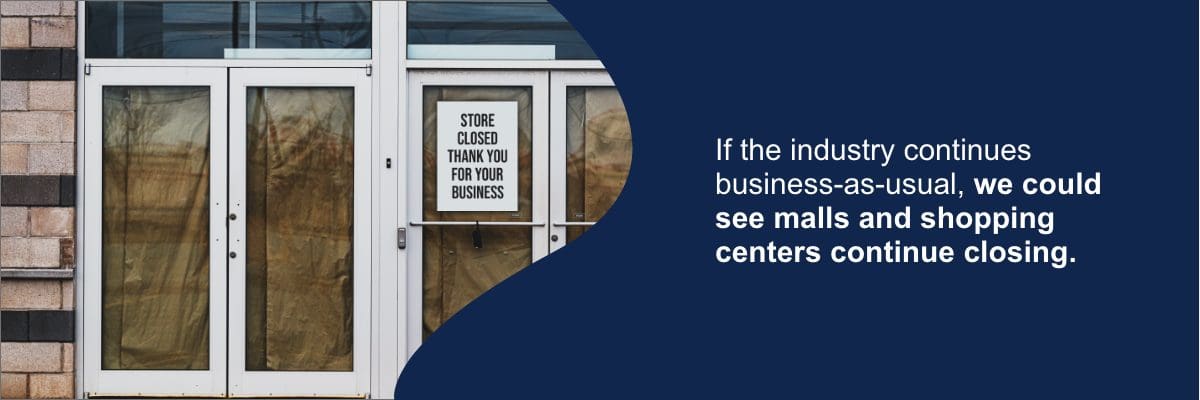
What Is the Future of Retail?
Despite what many believe, the future of retail is not doom and gloom. In fact, the future of retail is limited only by the industry’s imagination and the ability of those in the industry to connect buyers with their aspirations and values. If the industry is able to evolve and harness the change drivers of technology, the consumer and commercial considerations, the future of retail can be robust.
You can either inherit a future or design one, and whichever the retail industry chooses will determine what the future looks like. If the industry continues business-as-usual, we could see malls and shopping centers continue closing due to changing demographics, lack of community interest and increasing competition from online retailers.
If the retail industry is willing to evolve and adapt, however, the future of retail centers could be moving toward consumer engagement spaces (CESs). In this case, malls and shopping centers can flourish by catering to a diverse customer base and creating an experience rather than simply selling products and services.

How Technology Is Changing the Future of Retail
Within the next decade, many consumers in America will be digital natives. The technology these consumers have grown up with will form the infrastructure that facilitates and enables the way we live, socialize, work and shop. CESs will interface with the consumers who are well-versed in communicating and interacting via connected devices, platforms and locations on their phones and apps, using bots powered by artificial intelligence, the Internet of Things (IoT) and subscription services.
Technology as a Driving Factor in Retail
The future of retail will depend on how successfully CESs integrate technologies with their customers’ connections. In the past, a boom in American malls was linked to the behaviors of the Baby Boom generation and the growth in private car ownership. In European and Asian countries, shopping centers grew according to population density and mass transit hubs. Today, rather than powering systems, the primary role of technology is to connect consumers’ values and aspirations with sellers’ offerings.
While technology shouldn’t be underestimated as a factor in future retail, its role shouldn’t be overestimated either. A successful CES will embrace technology as a diverse set of tools that each serve a specific purpose and function.
How Consumers and Retailers Use Technology
To be successful in the future of retail, shopping centers should master different sets of technologies. One set of technologies are used by consumers to communicate, organize their lives and make transactions. The other set is used by businesses to:
- Track purchases
- Analyze behavior
- Identify shoppers
- Communicate with customers
- Develop real-time opportunities for marketing, advertising, merchandising and promotion
The technology consumers use has a multitude of purposes and functionalities — from voice-activated assistants to smart appliances to vehicles that store media to home electronics that offer subscription service purchases. A CES operator should be able to leverage this technology while shoppers are in or out of retail centers. As the technologies consumers use evolve from simple pattern recognition to cognitive intelligence, your customers will expect a frictionless, highly curated shopping experience.
Retail owners can use technology for big data collection, AI programs, tracking consumer behaviors and meeting consumer demands in real time.
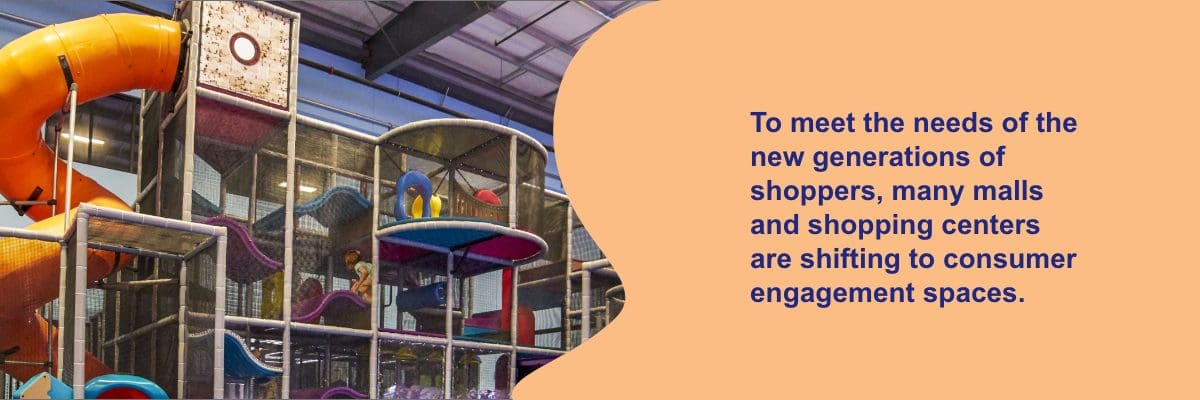
How the Consumer Is Changing the Future of Retail
The consumer is perhaps the most important factor that will impact the retail industry’s future. Retail success hinges on understanding the consumer, how they live and what they want from the retail experience. To meet the needs of the new generations of shoppers, many malls and shopping centers are shifting to consumer engagement spaces.
Demographics
The future of retail is tied to consumer demographics, and the growth and success of the industry are determined by its ability to react to changes in the physical location and composition of the consumer market. Today, six generations are included in the consumer market — millennials, Gen Z, Gen X, baby boomers, the silent generation and Alphas.
In the U.S., the growth in retail centers has outpaced the growth in population due to high consumer confidence, relative affluence, explosive urban and suburban home building and broad-based upward mobility. When retail real estate follows the people, the results prove successful.
Digital Generations
Though younger generations are the consumers of the future, baby boomers still exert disproportionate economic influence. Millennials have challenged the baby boomers’ dominance — a challenge that has been echoed by Gen Z. Millennials and Gen Z are now driving new demand, but their influence is still limited by older cohorts’ retention of generational wealth.
For the retail industry, this can present a challenge, as Gen Xers and baby boomers will retain a significant amount of wealth without spending on items that fuel retail growth. In the next couple of decades, millennials and Gen Zers will continue to represent key consumer targets in retail. To be successful, CES operators should aim to:
- Meet the needs of a certain cohort
- Establish several strategies that are aligned against multiple cohorts
- Create retail offerings to cut across the markets and appeal to the concerns and values of one or more generation’s subsets of shoppers
Baby boomers tend to be similar to one another, whereas the millennial and Gen Z generations celebrate diversity. These generations comprise a complex and varied consumer pool, where labels associated with race, ethnicity and religion don’t often apply. Many millennials and Gen Zers are also creating multiple digital personas online to represent themselves.
Shift From Ownership
Consumers in the younger generations value functionality over ownership. This preference is demonstrated again and again, as millennials and Gen Z continually show via their discretionary spending that they prefer experiences over products. While older generations shopped at retail centers to seek value expressed between the branded goods and the price, future CES should cater to the consumer base’s individual and collective values.
Younger generations are driving the growth of the sharing economy. This shift explains the success of many emerging businesses like Uber, Lyft, StyleLend and Rent the Runway. New consumers prefer authentic and personalized interactions with brands and establishing and maintaining strong connections with their local communities.
This preference is demonstrated by the success of Ratio Beerworks, Fiction Beer Company and Shinola. Ratio Beerworks and Fiction Beer Company are part of the group of craft and microbreweries in Denver. Shinola specializes in leather goods, bicycles, watches and stereo components. CES of the future will need to place more emphasis on providing experiences or services and goods that are local, authentic and based on values rather than on ownership for the sake of ownership.
How Commercial Considerations Are Changing the Future of Retail
If you don’t look further than the headlines, you might believe that we should expect a retail apocalypse or the death of retail. However, the retail industry is actually on the verge of a renaissance with greater possibilities for growth and success.
A retail renaissance will depend on how existing square footage is reconfigured. Rather than competing with digital businesses, a physical retail center may adopt the form of a smaller, dynamic format. Locations would then serve as a hub for interactive brand experiences or become an inventory-light retail center used for showrooming products, services and brands to complement and support online retailers. Even though the pace has slowed, American retailers are still opening new stores.
The future of retail will likely include short-term pop-ups and rich experience hubs:
- Short-term pop-ups: Brief pop-ups will allow retailers with less capital to reach customers and give established brands a chance to test approaches in micro and local markets. Pop-ups tend to gain popularity through their limited-time models and trending online.
- Rich experience hubs: We may also be able to expect rich experience hubs, as new consumers prefer having experiences over owning products. These physical spaces will use immersive technologies like augmented reality (AR), mixed reality (MR) and virtual reality (VR) to offer a unique environment and multisensory experience.
Though e-commerce will continue growing, most purchases will still be made in physical stores, and the shopping experience will be greatly influenced by the retailer center’s physical environment.
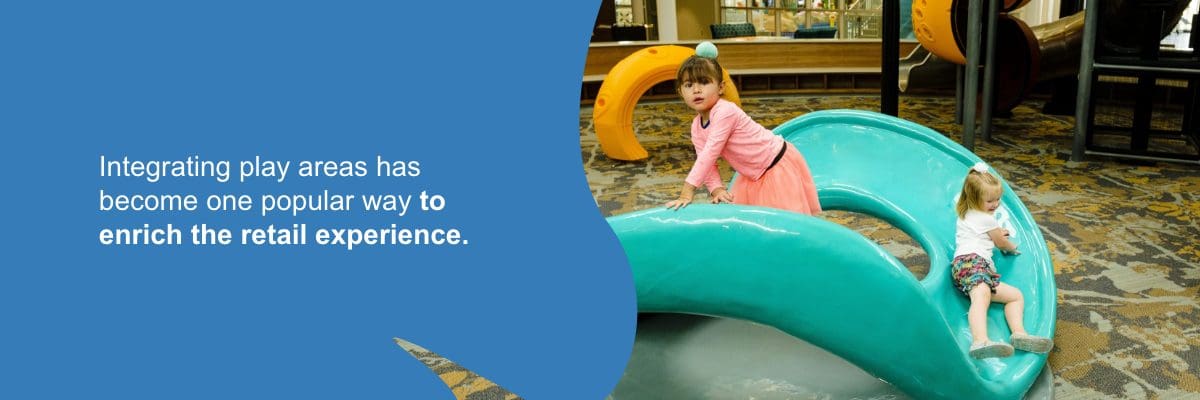
The Future of Play Areas in Retail Design
Despite how the industry and consumers are changing, retail owners and architects can stay relevant and adapt to these changes to stay successful. Integrating play areas has become one popular way to enrich the retail experience.
Changes in Safety Regulations of Play Areas
Play areas are safer now than they’ve ever been. Play equipment must comply with a list of regulations that have been established with the intention of making kids safer while they play. Of course, safety needs to be balanced with play value to ensure kids still want to interact with the play areas available to them in retail centers.
Impact of Technology on Play Areas
Technology is dramatically changing our lives, our shopping experiences and kids’ play areas. As such, retail centers and manufacturers of play equipment are taking advantage of the new opportunities and possibilities:
- Vehicles: Driverless cars may greatly affect play areas at shopping centers and malls. If fewer consumers own cars and more travel via driverless cars, streets and parking lots will no longer be packed with vehicles. Instead, these open spaces can present an opportunity for expansion of play areas and give kids more room to explore and have fun.
- Smartphone apps: Apps may encourage kids and parents to play together and collaborate in an interactive play area. Mobile phones have significantly changed how we live and communicate, giving us instant and constant connection and access to data at any time with just the click of a button. As technology advances, play may become increasingly immersive and offer a unique experience every time.
- Lighting: Developments in the lighting industry may be incorporated in play areas at retail centers. Possibilities include lighting games and the ability to project images onto surfaces to build a more immersive play environment. Play areas use a combination of fixed image and imagery that interacts and changes with movement.
The future of play areas in retail centers is limited only by imagination and our ever-progressing technology. There hasn’t been a more exciting time to be an architect or play designer, as emerging technologies and materials are creating countless opportunities for new designs.
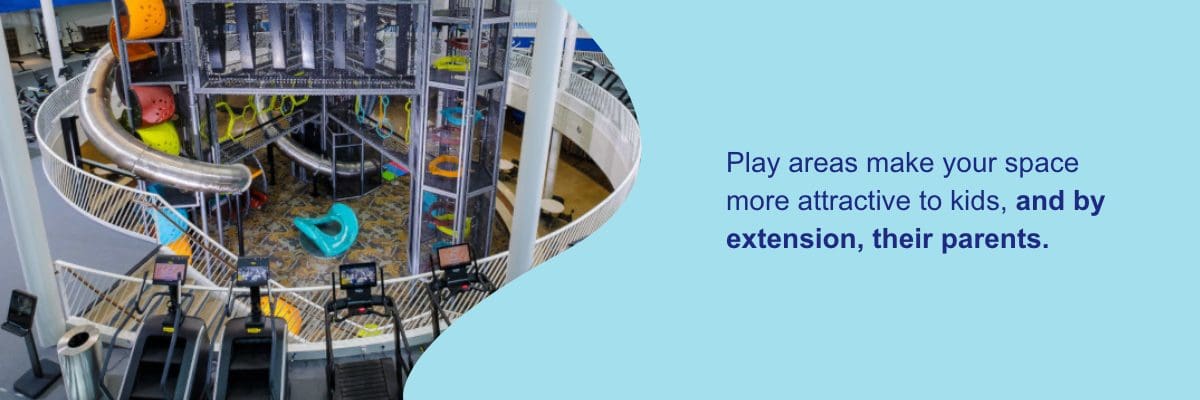
Benefits of Indoor Playgrounds to the Shopping Experience
Shopping is often a family experience, but kids tend to get bored quickly and may not enjoy spending hours browsing through stores. This is why mall playground equipment is so essential for a retail center. Play areas make your space more attractive to kids, and by extension, their parents. Kids may even ask their parents to visit your retail center so they can have fun on the indoor playground.
Beyond increased interest, our indoor playgrounds from Soft Play® can offer the following benefits to your retail center:
- Customizability: Our indoor play equipment can be customized to meet the needs of any space or age group. Regardless of whether you have a limited amount of space or a large area, we can customize our products to your exact needs. We can also target the age group of your visitors’ kids, allowing you to best serve your customers and ensure the play area is appropriate.
- New experiences: With an indoor play area, you’ll be offering your visitors a unique, fun experience. This appeal can be particularly valuable in the winter months or unfavorable weather when families are seeking alternatives to outdoor activities.
- Increased return on investment (ROI): An indoor playground can improve your ROI by increasing the frequency and length of each visit, and when your visitors stay longer, they’ll spend more.
- Quality and durability: Our equipment is durable and designed to withstand high traffic environments, so you can offer your visitors an enjoyable play experience for many years.
- Branding opportunities: We understand how important it is to create a signature experience that will attract more shoppers to your retail center. At Soft Play, we can help your shopping center with branding and theming to build an immersive experience with a cohesive color scheme.
- Rigorous safety standards: Our mall playground equipment is thoroughly tested before the installation process, helping ensure the safety of every kid who interacts with the equipment.
Soft Play’s Indoor Play Spaces
To enjoy those benefits, look no further than indoor play spaces from Soft Play that are accessible to kids of all ages and abilities. For more than 30 years, Soft Play has been making retail and shopping centers fun family destinations, and we can do the same for your business.
An imaginative, exciting play experience is not something online sellers can compete against. Our playground consultants can work with you regardless of budget and space to build and finance your indoor play area. At Soft Play, we offer a few indoor play spaces that are great for retail centers.
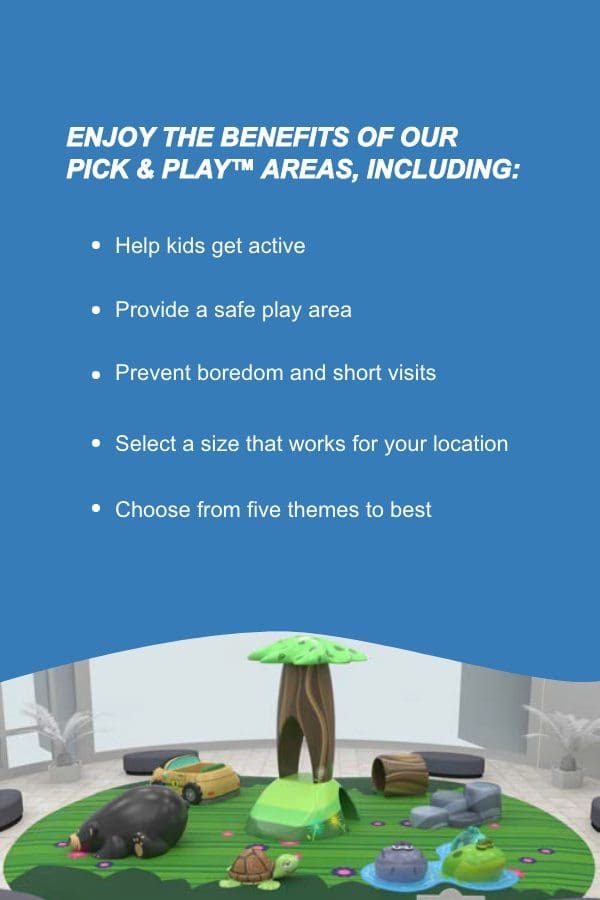
Pick & Play™
Our Pick & Play™ areas are soft sculpted foam products that feature Toonies. These foam play elements can offer your retail center a fun, engaging and imaginative space for kids to play and exercise. You can choose from five different themes and three sizes. We also offer a choice between two play area styles — Corner and Freestanding.
Kids can develop their gross motor skills via low-profile climbers, crawl tunnels and ramps. They’ll also build their confidence and test spatial relationships while having a blast! Our Pick & Play™ areas are ready for immediate use — our products are in stock and available for use in your retail center as soon as they’re shipped and set up in your space. Enjoy the benefits of our Pick & Play™ areas, including:
- Help kids get active
- Provide a safe play area
- Prevent boredom and short visits
- Select a size that works for your location
- Choose from five themes to best fit your retail center’s brand
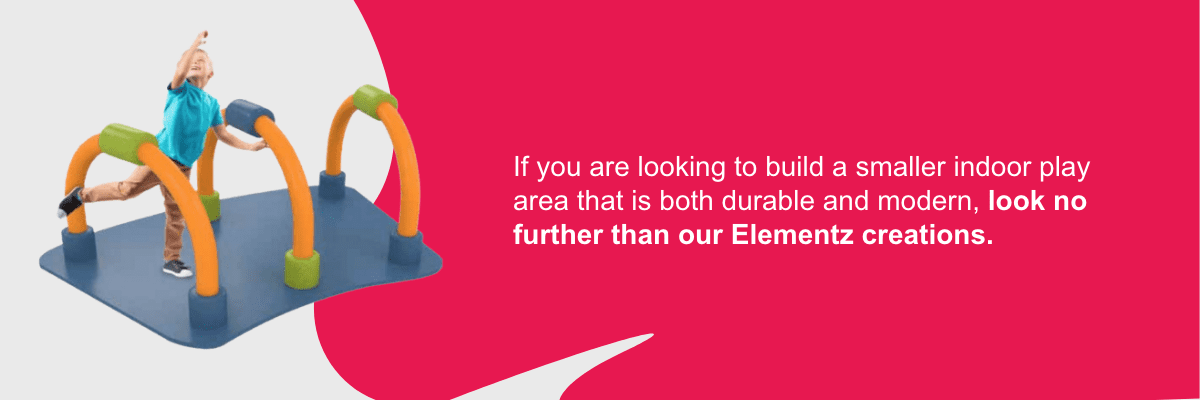
Elementz
Our Elementz line includes play components made of soft sculpted foam. This play equipment facilitates free play, imagination and creativity. If you are looking to build a smaller indoor play area that is both durable and modern, look no further than our Elementz creations. You can choose from a package option or individual play pieces depending on your retail center’s needs. Our Elementz products are commonly used in:
- Zoos
- Hotels
- Resorts
- Stadiums
- Daycares
- Museums
- Aquariums
- Restaurants
- Cruise ships
- Theme parks
- Waiting rooms
- Early childhood centers
- Family entertainment centers
- Churches and other places of worship
When you choose our Elementz line, you can build a perfect indoor space where kids of all ages and abilities can play. Our play surfaces are designed with UV stable colors, and the smooth surface allows for easy cleaning and maintenance. Caregivers will be able to keep an eye on the kids from seating that can either be purchased individually or within a packaged group.
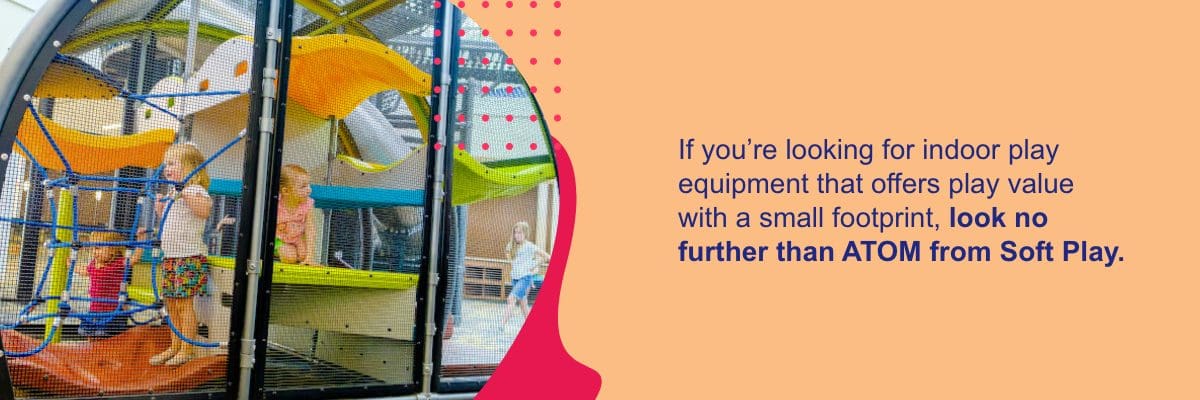
ATOM Play Areas
If you’re looking for indoor play equipment that offers play value with a small footprint, look no further than ATOM from Soft Play. With our play products, you can create a fun, memorable experience on a small budget, promoting play in your community and attracting families. Our ATOM play areas feature the following:
- Sit-N-Spin
- Fun Ride Slide
- Scoop Climber
- Diamond Pass
- Musical Drums
- Ripple Platform
- 3-in-a-Row Game
- Hammock Hangout
Whether you believe our Pick & Play™ areas, Elementz line or ATOM play areas are right for your retail center, browse our indoor play collections for the right additions to your shopping experience. You can also reach out to us for a free design consultation.
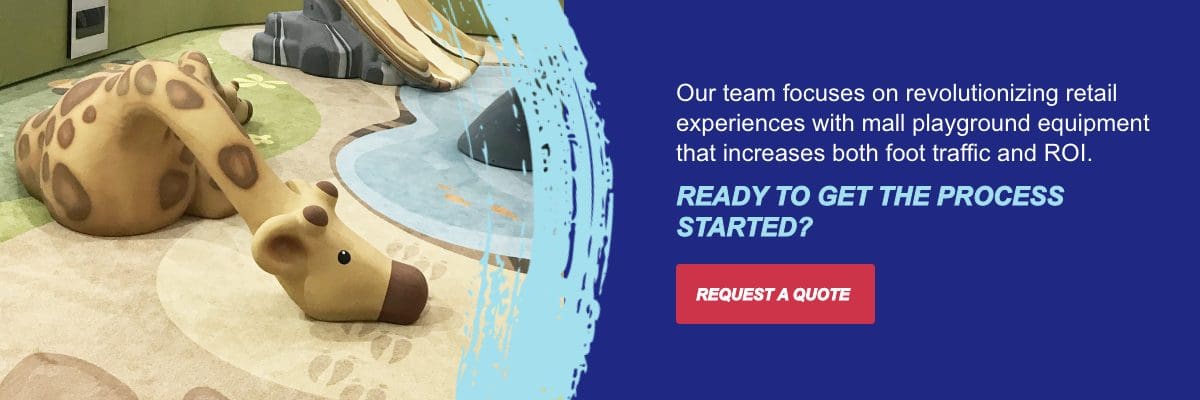
Prepare for the Future of Retail With Soft Play
If you are an architect or retail center owner, Soft Play can help you prepare for the future of the retail industry. Our team focuses on revolutionizing retail experiences with mall playground equipment that increases both foot traffic and ROI. With indoor playgrounds or play equipment, families will be drawn to your retail center more frequently and spend more time there.
Ready to get the process started? Request a quote for your project today or contact us at Soft Play to speak with your local representative and learn more about how we can help your business improve the customer experience.
